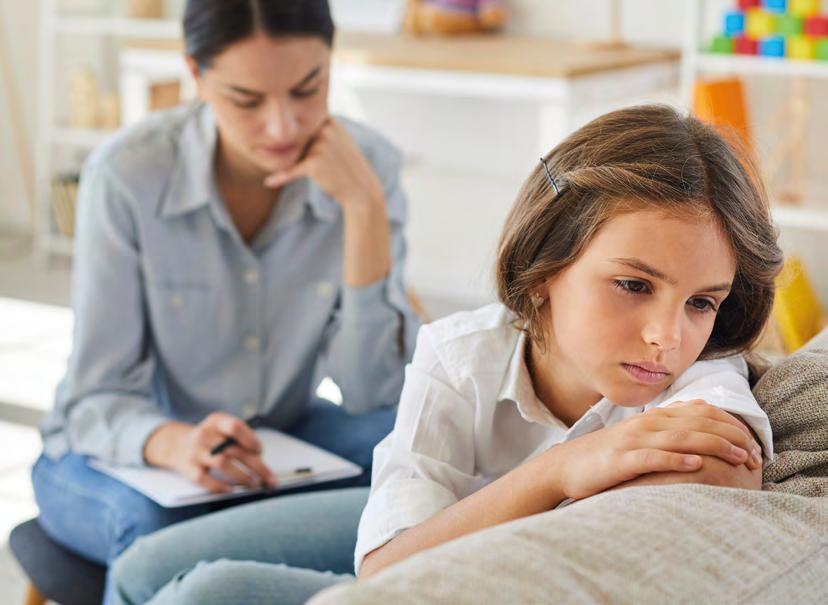
3 minute read
ADHD in girls: workshop to support the overlooked
As I muddled through school, work and life I always felt like I had not achieved my potential. I was the student who was always in the background, not understating what was expected of me in the classroom. After school I was the girl who tried to blend in and do what was expected of me, copying social cues and not quite feeling comfortable in my own skin. As an adult I was trying to conform to what I thought I should be doing at that time in life. I had periods of time where I battled with my mental health as I was frequently questioning myself. I was always seeking and searching for something and this often came in the form of risk-taking behaviours. I struggled with money management and had a constant feeling that my life was in a state of chaos.
It was only after several career changes and diversions in life that I began to understand the traits of ADHD and recognised them in myself. I started a career in education, and this is where my lightbulb moment came. I suddenly started to see myself and my behaviours in the students that I was working with. I had always felt like I had failed at school but, on reflection, school had failed me.
We are fortunate now that we have significantly more research and support for neurodiversity than we had 20 years ago. This vital information is now being used to train and inform school staff at all levels. Teachers and support staff are equipped with the knowledge and skills to identify pupils’ needs and behaviours so diagnosis, intervention and support can be put in place earlier, reducing barriers.
Sally has been a teaching assistant at Meadow Park PRU for two years. Prior to that, for seven years she worked with young people with complex needs at Bluebell Park. Sally has personal experience dealing with ASC/ADHD/Type 1 diabetes and she is passionate about educating people on the inattentive side of ADHD, which often goes unnoticed in girls.
This was not the case for me as student and young adult. I was one of the overlooked females. I had ADHD without knowing what it was, but I could feel its powerful impact on my life; every choice and decision I had made had likely been influenced by my neurodiversity.
Working at Meadow Park School was the first time that I really felt validated. What I had been feeling, thinking and experiencing was in fact ‘normal’. I felt at ease instantly with both colleagues and students. The staff had a plethora of knowledge surrounding ADHD and the students were showing similar behaviour patterns that I had lived through at their age.
If you were to ask most adults today what ADHD is, they would likely be able to give you a response. Would that response be well informed and accurate, though? You have probably heard people say that ADHD means: extroverted, a fidget, struggling at school, cannot pay attention, hyperactive, affects boys more than girls.
These misconceptions can be harmful and result in many people going through life questioning their behaviours, thoughts and actions (just as I did). This is what spurred me on to make a difference for the young females that I work with.
I wanted them to feel seen and heard and feel that sense of affirmation much sooner than I had. My diagnosis came in October 2022 at the age of 42. From this I chose to take medication and it was the first time that I had felt calm and at ease in my own body. I no longer had the feeling that my internal working model was constantly running on motor.
“You need to try harder!”, “Pay attention”, “Stop talking” are phrases that have circled in my mind for years. I do not want the students that I work with to have those haunting phrases pop up repeatedly throughout their lifetime. I want them to have an inner voice that tells them that they are more than capable of succeeding in life despite being neurodivergent. This is what prompted me to speak with the SENCO about the possibility of developing a workshop for female students in our school who have a diagnosis or present with traits of ADHD. The group runs over six sessions and covers topics such as: how ADHD makes them feel physically and emotionally, the science of the brain, executive dysfunction, masking behaviours, how ADHD in females presents differently to males, risk taking behaviours and reasons they occur.
I co-run this group with the school therapist, who delivers a session on holistic sound therapy for people with ADHD.
The feedback from the students has been extremely positive; they have enjoyed learning about themselves and their diagnosis. As a result of being open and honest about my own personal experiences, the students have been relaxed and are forthcoming about their own difficulties and challenges. This has helped to shape and tailor the sessions to best meet their needs.
MY TOP TIPS FOR ANYONE WHO WANTS TO SET UP THEIR OWN ADHD SUPPORT GROUP WOULD BE:
Speak to someone who has a diagnosis of ADHD
Share first-hand experiences
Keep the groups small
Make the environment low stimulation and relaxed
Have a clear focus for each session but provide opportunity for the students to share their own voice and guide the session
Keep sessions short; I have found that 30 minutes works well










